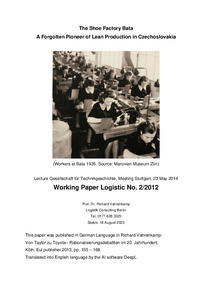| dcterms.abstract | The paper focuses on the managerial aspects of the loosely coupled units in Bata's shoe factory in Zlin as a precursor of lean production that was forgotten. The Bata factory plant in Zlín, Moravia, was built in the avant-garde style of modernism and grew rapidly in the 1920s. Comparable to Henry Ford, Bata pursued a concept of social engineering. He expanded the factory complex in Zlín to include housing for the workers, sports facilities, educational institutions and a self–service department store.
The Bata factory was not a giant factory in the style of the 1920s, but merely three-storey buildings measuring 80 by 12 metres. Each of these factory buildings housed two workshops for final production. In this way, Bata was already given small, manageable workshop units through the architecture. Each workshop employed 150 to 200 workers and had an output of about 2000 pairs of shoes per eight-hour shift.
The workshops for final production, the preliminary stages of production and the supply facilities were also organised according to the principle of the profit centre or cost centre, i.e. the units had to make a profit under given general conditions.
The unit leaders were supposed to make a profit, which they could only secure through economical management and critical examination of incoming and outgoing materials. They could distribute the profit among the workers in the unit according to a pyramid system.
Bata had recognised the large amount of control cost (in terms of institution economics) of large centralized factories and implemented his idea in such a way that he divided the final production into 36 small, parallel units. Bata combined the mass production of shoes with a vertically integrated system of mass sales. Bata inferred a large amount of control cost in his distribution system due to complex rules. In order to circumvent import duties, he built many his own manufacturing plants abroad. Like Henry Ford, Bata also developed a fierce publicity campaign to publicise his model factory and to be celebrated as a benefactor and "Czech Ford". Ironically, the approaches pursued by the capitalist entrepreneur Tomas Bata in Zlín were in broad agreement with communist ideas to link work and private living. | eng |


